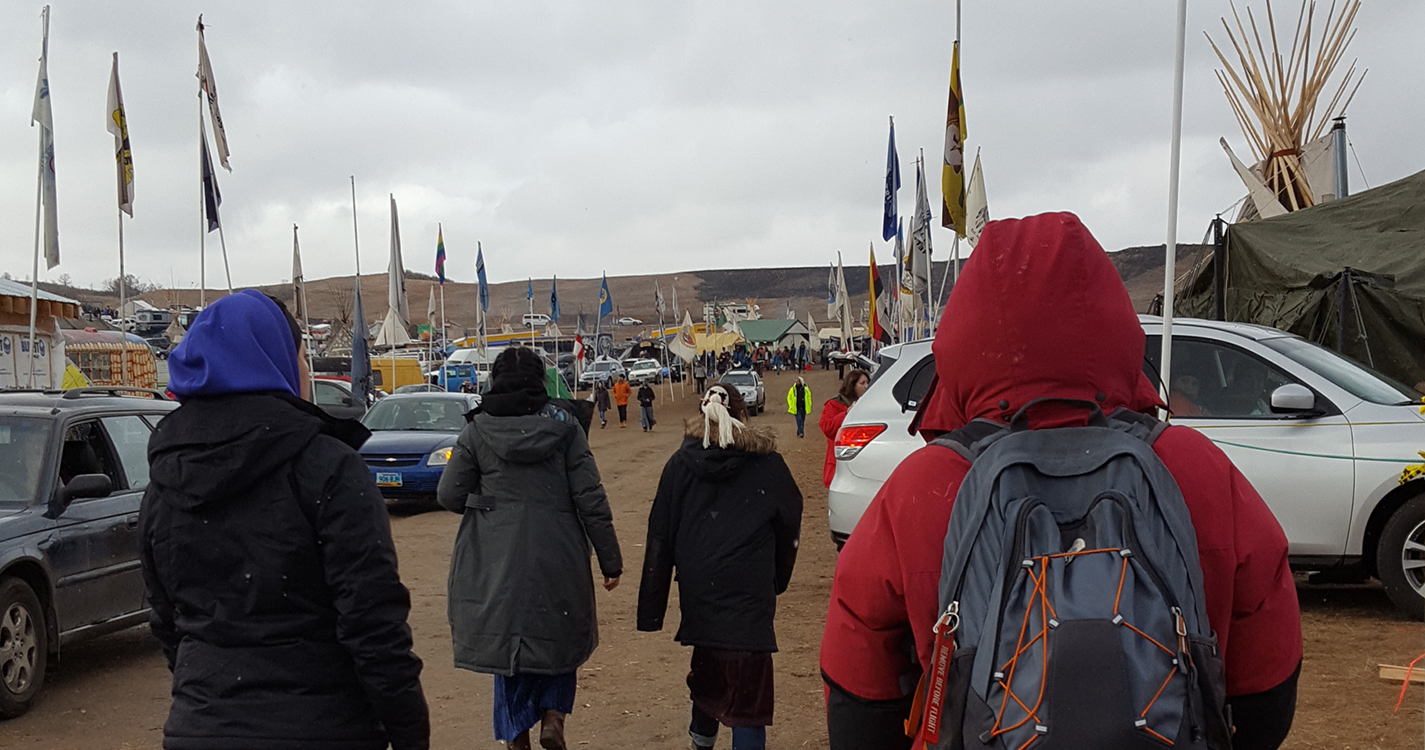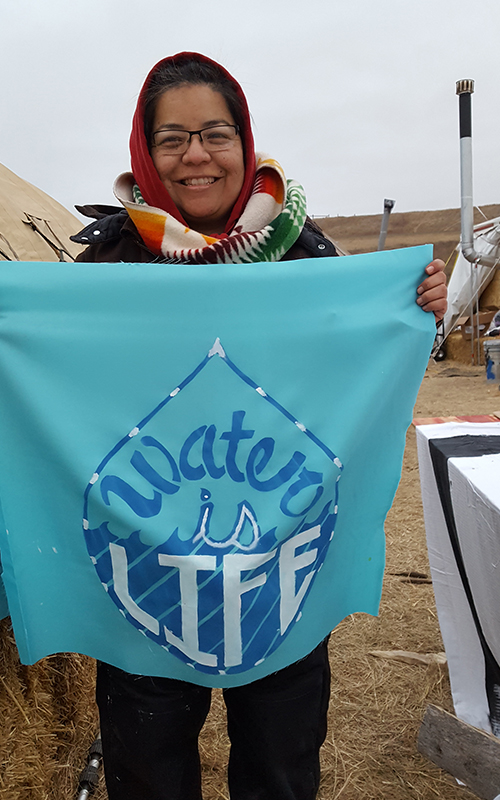After driving hundreds of miles and arriving in darkness late at night, Liz Bahe pulled up to an out-of-the-way campsite in southern North Dakota. She felt scared.
The remoteness of the location didn’t worry her — in fact, she was joining thousands of people. Her concern arose from the social media reports from camp leadership she’d read about the Oceti Sakowin campground — the heart of months-long, often-violent clashes between law enforcement officials and people protesting the construction of the 1,172-mile Dakota Access Pipeline.
As Bahe, her daughter Haileigh M. Lowley and three Willamette students — Sadarah Witherspoon ’17, Montreal Gray ’19 and Alexus Uentillie ’19 — approached the camp hand-in-hand, the images they’d seen in the media became an unsettling reality. Blinding floodlights highlighted what looked like a military base, and a plane constantly circled overhead. Two people supported a man as they walked him to a medical vehicle.
Bahe, Willamette’s director of Native American programs and an enrolled tribal member of the Navajo Nation with paternal ties to the Lac du Flambeau Band of Lake Superior Chippewa, wasn’t sure what to expect at the protests near the Standing Rock Sioux Reservation. But she felt she had to go to support the protesters — whom Bahe calls “water protectors” — and stand with the Standing Rock Sioux tribe.
“We went in with prayer and our belief systems,” Bahe says. “We knew what we were doing was right. And that these are people we want to stand with.”
Protecting the future, honoring the past
Protesters, who’ve been at the campsite since August, say the pipeline will run through sacred Standing Rock Sioux tribe burial sites near the reservation and threaten the environment.
“The peaceful protestors are using free speech to challenge a corporate entity bringing in a pipeline that will potentially pollute a water source,” Bahe says. “The protest is about the 17 million people who will be affected (by the pipeline).”
All three students requested to join Bahe on the trip during Willamette’s weeklong Thanksgiving break. Gray, a native of the Choctaw tribe, says she wanted to help others and to show her “love of the community, the love of the land.”
“Right now, it just looks like people are disrespecting other people,” she says. “But the impact of the pipeline in the future will be devastating to people who live there, even non-Native people, for generations to come.”
In addition to protesting the pipeline, Bahe wanted to honor the struggles of her ancestors, who, she says, were shot, tortured and imprisoned in historic conflicts with the federal government over land ownership.
Even as recently as the 1990s, her family was forced to relocate from a reservation in Arizona.
After Congress approved the Navajo-Hopi Land Settlement Act of 1974, which was intended to settle disputes between the tribes, she says rangers harassed Navajo tribe members and collected their animals. Such incidents inspired Bahe to attend college and pursue a career educating others.
Changing perspectives
The Willamette group spent three days on the road to Standing Rock, stopping at Sitting Bull College, a tribal college in Ft. Yates, North Dakota, to visit with students and community members. They were able to secure a hotel room for their visit to Oceti Sakowin.
Bahe says their experience at the camp did not reflect news reports, and she felt a strong distrust for media after they left the state. She felt that language on social or traditional media used to describe protesters or their behavior — such as “terrorist acts,” “encroaching on public land” or “lawbreakers” — villainized protesters. Native people were always described as “other,” she says, “not American citizens.”
Bahe says she saw law enforcement officials use water cannons against people in freezing temperatures, and she heard the pop of guns used to shoot rubber bullets. She recalls seeing a young man coughing from tear gas, with large rubber bullet wounds covering his back and sides.
“Had they been real bullets, he wouldn’t have been talking to me,” she says. “He’s about 20, 21. He’s someone’s child.”
The Willamette group mostly witnessed acts of kindness — such as protestors sharing chocolate and hand-warmers — and people striving to create a positive environment and sense of community.
“That’s what kept people there and sustained the camp,” Gray says.
Although they didn’t join protesters on the front lines, the Willamette group helped feed the fires, bought supplies and served food. Gray says the trip made her reconsider her future. As a civic communication and media major, she’d planned to be a news anchor. Now, she’s considering a law career.
Bahe says Willamette can also learn from Standing Rock in terms of honoring and working with “the First Nations and the first people who were here.”
“We have nine federally recognized tribes here in Oregon,” she says. “We talk about having a sense of place as our focus. Beyond my role, how do we do that as an institution?”




